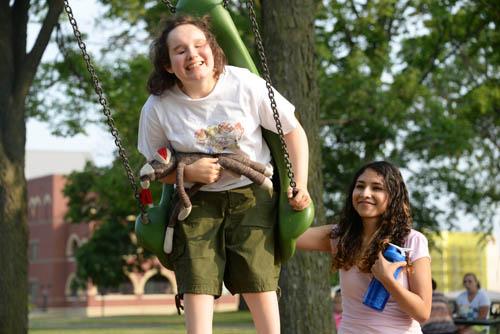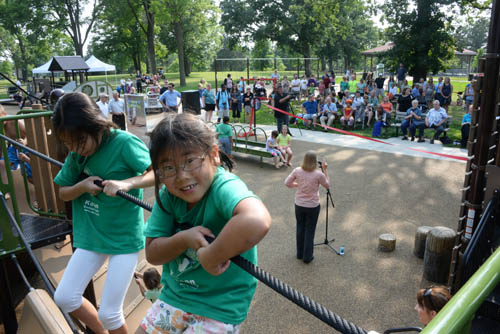As children kick their heels and swing into the air, a father in a wheelchair is able to roll up to the swing set and place his daughter on a swing. Nearby, a child in a wheelchair can join his playmates on a multi-level climbing structure, thanks to a ramp from the sidewalk.
On July 31, the Minneapolis Park and Recreation Board opened two new play areas at Wabun Picnic Area in Minnehaha Regional Park. One of them, the Wabun Universal Access Play Area, is accessible to children and adults of all physical abilities.
 The catalyst for the project was Peggy Halvorson, who was inspired by an organization in North Carolina that opened a universally accessible playground. “It occurred to me that this is something that every community should have,” she said.
The catalyst for the project was Peggy Halvorson, who was inspired by an organization in North Carolina that opened a universally accessible playground. “It occurred to me that this is something that every community should have,” she said.
Halvorson established and became chair of Falls 4 All, a volunteer committee whose mission was to unite the community through providing a universally accessible play area for people with and without disabilities. The committee, working in conjunction with the Minneapolis Park and Recreation Board and People for Parks, raised $456,000 towards construction and implementation.
“I love it,” Halvorson said after the grand opening. “I see kids in wheelchairs, kids with sensory issues, all playing together [and think] ‘OK, this was four years of hard work and it was worth it.’” She said that she has gotten feedback from other people who have been to the park and are pleased with the playground.
Children and parents with disabilities find inclusion
“Universally accessible means that it is for everyone,” said Geri Gavanda Mauck, a mother of two adopted children with disabilities, Carly and Dan. Daniel, 24, is legally blind and has simple tic Tourette syndrome. Carly, 18, was born without eyes, is nonverbal, and uses a wheelchair. She also has a brain malformation.
 Mauck attended the grand opening of the universally accessible play area with Carly. “Her favorite thing to do is be on the swing,” said Mauck. “She loves the motion and it also improves her brain function.”
Mauck attended the grand opening of the universally accessible play area with Carly. “Her favorite thing to do is be on the swing,” said Mauck. “She loves the motion and it also improves her brain function.”
Mauck said that attending the event informed her about other ways the play area is important. “From a parental perspective, you think the playground was built for children with special needs,” said Mauck. “[But] my husband noticed, during the grand opening, that a woman in a wheelchair rolled up to the swing with their child in her lap so she could place her child in the swing. Sometimes you don’t think that parents who are disabled miss out on those kinds of experiences with their children.”
Allies are critical in raising funds
Mauck gave a special thanks to people like Halvorson. “It is great to have people who are willing to advocate and fundraise,” said Mauck. “Being a parent of a child with special needs, you spend a lot of time advocating for the child’s needs at church and school, and you are worn out and tired. Where would you find the energy to go out and do fundraising?”
Falls 4 All Committee made the idea of a play area a reality. Halvorson was looking for parks that wanted to have accessible playgrounds. The Minneapolis Park Board quickly replied to her inquiry, saying they were interested and that there was a picnic area due for renovation.
For a play area to be universally accessible, it must have at least 70% of its play features designed to be fully accessible. A critical feature is rubberized covering under the whole play area so wheelchairs have easy access to all the play structures, including a merry-go-round with high molded seats.
Among the other amenities is a perennial garden.
“The garden is intended for people to go relax and calm down,” said Minneapolis Park and Recreation Board Project Manager Andrea Weber. In the garden, there are benches to sit down and boulders for park attendees to climb on. “It’s good for kids with autism and other cognitive disorders,” said Weber.